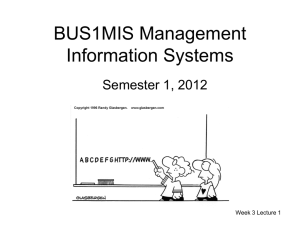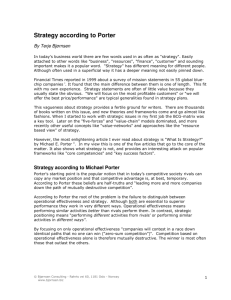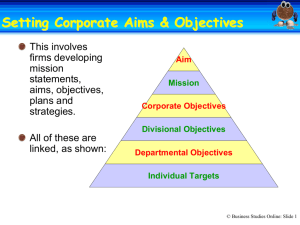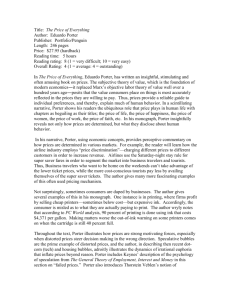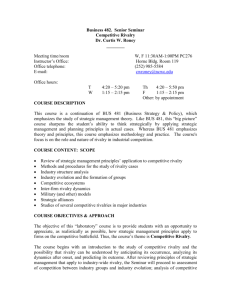9 Porter's Five Forces and Generic Strategies
advertisement
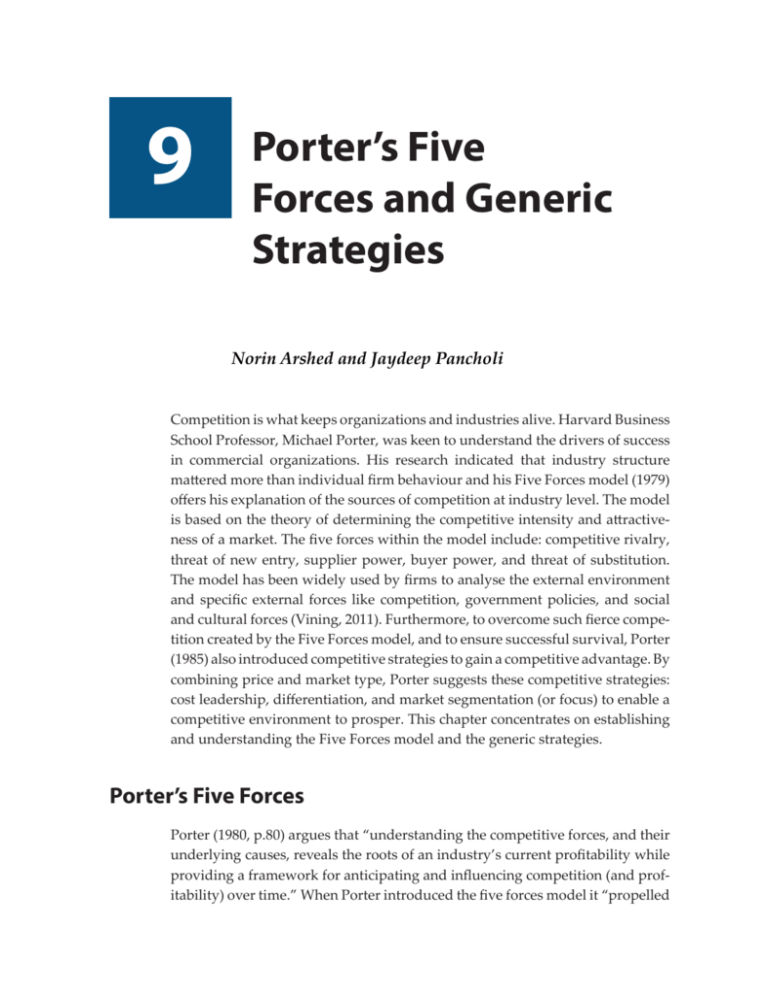
9 Porter’s Five Forces and Generic Strategies Norin Arshed and Jaydeep Pancholi Competition is what keeps organizations and industries alive. Harvard Business School Professor, Michael Porter, was keen to understand the drivers of success in commercial organizations. His research indicated that industry structure mattered more than individual firm behaviour and his Five Forces model (1979) offers his explanation of the sources of competition at industry level. The model is based on the theory of determining the competitive intensity and attractiveness of a market. The five forces within the model include: competitive rivalry, threat of new entry, supplier power, buyer power, and threat of substitution. The model has been widely used by firms to analyse the external environment and specific external forces like competition, government policies, and social and cultural forces (Vining, 2011). Furthermore, to overcome such fierce competition created by the Five Forces model, and to ensure successful survival, Porter (1985) also introduced competitive strategies to gain a competitive advantage. By combining price and market type, Porter suggests these competitive strategies: cost leadership, differentiation, and market segmentation (or focus) to enable a competitive environment to prosper. This chapter concentrates on establishing and understanding the Five Forces model and the generic strategies. Porter’s Five Forces Porter (1980, p.80) argues that “understanding the competitive forces, and their underlying causes, reveals the roots of an industry’s current profitability while providing a framework for anticipating and influencing competition (and profitability) over time.” When Porter introduced the five forces model it “propelled 152 Enterprise and its Business Environment strategic management to the very heart of management agenda” (Grundy, 2006, p.213). Over the years, Porter’s model has offered the following insights and attributes into competitive industries: It implied micro-economic theory into just five major influences. It effectively and before its time applied ‘systems thinking’. It showed how ‘competitive rivalry’ is very much a function of the other four forces. It helped predict the long-run rate of returns in a particular industry. It went beyond a more simplistic focus on relative market growth rates in determining industry attractiveness. It helped combine input-output analysis of a specific industry with industry boundaries via entry barriers and substitutes. It emphasized the importance of searching for imperfect markets, which offer more national opportunities for superior returns. It emphasizes the importance of negotiating power and bargaining 153 Porter’s Five Forces and Generic Strategies arrangements in determining relative market attractiveness. It focused managers on the external environment far more than traditional ‘SWOT’ analysis. (Grundy, 2006, p. 215). Potential entrants Threat of new entrants Suppliers Bargaining power of suppliers Competitive rivalry Buyers Threat of substitutes Bargaining power of buyers Substitutes Figure 9.1: Porter’s Five Forces Model 9 Porter’s Five Forces and Generic Strategies 153 As such, to ensure competitive advantage, strategists and organizations need to understand the forces that determine the state of competition in any given industry. The key five forces involve (Figure 9.1): 1 The ease of entry (dependent upon entry barriers), 2 The power of buyers and, 3 The power of suppliers, whereby the bargaining power of each group influences profitability, 4 The availability of substitutes, which could potentially include alternatives for consumers, and, 5 The degree of rivalry among competitors. Airline industry example In order to facilitate understanding of these five forces in practice, this chapter will examine each of these forces in relation to the airline industry. Before discussing each force it is important to provide an overview of the airline industry. The airline industry has evolved over the last 60 years, with more than 8 million people flying daily (IATA, 2015), and 3.3 billion passengers flying in 2014 (equivalent to 44% of the world’s population); the global airline industry turnover is estimated at $743 billion in 2014 (IATA, 2014). Despite this evergrowing increase, in 2012 airlines made profits of only $4 for every passenger carried (The Economist, 2014). This has been due to the intensive competition and de-regulation (Wang et al., 2015) within the industry, causing price wars that have affected the industry as a whole. Competitive rivalry Competitive rivalry has been described as the one of the most important of the five forces because it describes the degree of competitiveness amongst companies. If there are companies competing with each other, pressure leads businesses to change prices; this in turn may lead to price wars. Consequently, further investments into research and development may be made, while an increase in the drive for promotion, such as sales and marketing, might be warranted. Given this, organizations will need to increase their costs, in turn lowering their profits. There are a number of factors that determine the intensity of competitive rivalry (Table 9.1). 9 154 Enterprise and its Business Environment Table 9.1: Factors affecting competitive rivalry Factor Information Number of competitors in the market Competitive rivalry will be higher in an industry with many current and potential competitors – all businesses looking to strive for market leadership. Market size and growth prospects Competition is always most intense in stagnating markets. Product differentiation and brand loyalty The greater the customer loyalty, the less intense the competition. The lower the degree of product differentiation the greater the intensity of price competition. The power of buyers and the availability of substitutes If buyers are strong and/or if close substitutes are available, there will be more intense competitive rivalry. Capacity utilization The existence of spare capacity will increase the intensity of competition. The cost structure of the industry Where fixed costs are a high percentage of costs then profits will be very dependent on volume. As a result there will be intense competition over market shares. Exit barriers Even if companies are receiving low or negative returns on investments, it is often difficult or expensive to exit an industry. The major barriers include: Specialized assets Fixed costs of exit Strategic interrelationships Emotional barriers Government and social restrictions Source: Adapted from Porter (1988) Intense competitive rivalry has three main benefits. The first benefit involves companies differentiating themselves from one another to gain a larger market share. In such cases they will invest in research and development, allowing innovation to flourish. Second, they will lower prices because of the many choices available to their consumers. The fear of losing a customer to a competitor will mean that not only will prices change but companies will make an effort in understanding and meeting the consumers’ demands and tailoring them in accordance. Lastly, competition also drives economic growth where technological advances, such as the introduction of computers and robots, may mean a reduction on the minimum efficient scale of enterprise.
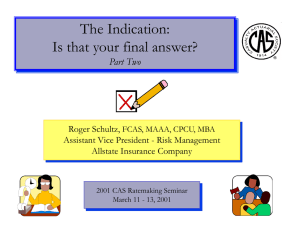

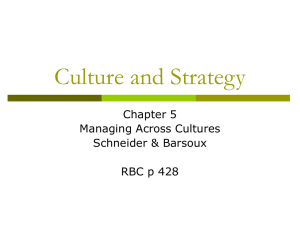
![[5] James William Porter The third member of the Kentucky trio was](http://s3.studylib.net/store/data/007720435_2-b7ae8b469a9e5e8e28988eb9f13b60e3-300x300.png)

